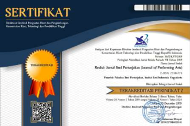Pemakaian Kosakata Tema Kesehatan dalam Penciptaan Lirik Lagu Anak
Abstract
The Use of Health-Themed Vocabulary in Creating Children's Song Lyrics. Children's songs can convey the songwriter's messages and describe the children's lives and the environment through their perspective in the lyrics. In this context, the song is the unity of the melody and lyrics. In addition, songs can also function as a means of exploration, information, expression, and entertainment. This research was conducted to determine the description of health-themed vocabulary uses in children's song lyrics. How health vocabulary, especially in children's song lyrics, is used by children's songwriters. The study sample was a set of songs from a collection of the best children's songs, Dendang Kencana. The research used a descriptive-analytical method, which was preceded by a literature study followed by determining the lyrics of the health-themed song lyrics created by the songwriters of Dendang Kencana song album. Data collection was carried out by using the ten-song lyrics with scores. Those songs were the best songs chosen from the Dendang Kencana album. The two songs were the best-selected songs in the Dendang Kencana Children's Songwriting Competition in 2017. The lyrics were observed and recorded, and analyzed to determine the vocabulary used within the children's song lyrics. The vocabulary was then grouped and interpreted according to the purpose of this study. The results show that in children's songs, the vocabulary of the health-themed is often used by the songwriters to emphasize the importance of being healthy and healthy since childhood. The vocabulary is related to children's daily activities, such as bathing, washing hands, washing hair, maintaining a healthy body, exercising, eating nutritiously, and other movement activities.
Keywords
Full Text:
PDFReferences
Lagu Anak Pilihan Dendang Kencana. (2018). Jakarta: PT Grasindo.
Badan Pengembangan dan Pembinaan Bahasa, K. P. dan K. R. I. (2020). KBBI Daring. Retrieved from https://kbbi.kemdikbud.go.id/
Bjorklund, D. F. (2005). Children’s Thinking: Cognitive Development and Individual Differences, Fourth Edition. Australia: Belmont, CA Thomson/Wadsworth.
Byrne, Brian; Fielding-Barnsley, Ruth; Ashley, L. (2000). Effects of Preschool Phoneme Identity Training after Six Years: Outcome Level Distinguished from Rate of Response. Journal of Educational Psychology, 92(4), 659–667.
Campbell, Patricia Shehan; Scott-Kassner, C. (2013). Music in Childhood: From Preschool through the Elementary Grades (with Premium Website Printed Access Card), 4th Edition. Boston, Massachusetts, United States: Cengage Learning.
Chomsky, C. (1969). The Aquisition of Syntax in Children from 5 to 10. Cambridge (Mass): MIT Press.
Dardjowidjojo, S. (2010). Psikolinguistik: Pengantar Pemahaman Bahasa Manusia. Yogyakarta: Yayasan Obor Indonesia.
Djajasudarma, F. (2006). Metode Linguistik Ancangan Metode Penelitian dan Kajian. Bandung: PT Refika Aditama.
Djawanai, S. (2009). Telaah Bahasa, Telaah Manusia. Pidato Pengukuhan Jabatan Guru Besar Pada FIB UGM 4 November 2009. Yogyakarta.
Djohan. (2003). Psikologi Musik. Yogyakarta: Penerbit Buku Baik.
Dodge, D.T., Colker, L.J.; & Heroman, C. (2002). The creative curriculum for preschool, fourth edition. Washington, DC: Teaching Strategis, Inc.
Flavell, J. H. (1985). Children’s Oral Communication Skills. New York: Academic Press.
Fletcher, P. (1991). Education and Music. Great Britain: The Alden Press.
Floyd, M. (1998). World Musics in Education. England: Scolar Press.
Gimson, A. C. (1989). An Introduction to the Pronunciation of English. London: Edward Arnold.
Hoffer, R. C. (1983). Introduction to Music Education. California: Wadsworth Publishing Comp.
Hurlock, E. B. (1978). Perkembangan Anak Jilid I, terjemahan dari Bahasa Inggris oleh Tjandrasa & Zarkasih. Jakarta: Erlangga.
Huttenlocher, J; Vasilyeva, M.; & Shimpi, P. (2004). Syntactic Priming in Young Children. Journal of Memory and Language, 50, 182–195.
Kaswanti Purwo, B. (1991). Perkembangan Bahasa Anak: Pragmatik dan Tata Bahasa, dalam Soenjono Dardjowidjojo: Linguistik Neurologi-PELBA 4. Jakarta: Lembaga Bahasa Unika Atmajaya.
Keraf, G. (1980). Komposisi. Flores: Penerbit Nusa Indah.
Nurgiyantoro, B. (2005). Sastra Anak: Pengantar Pemahaman Dunia Anak. Yogyakarta: Gadjah Mada University Press.
Permana, Catur Surya; & Sigit, R. (2017). Model Penciptaan Karya Lagu Anak Populer yang Berangkat dari Nilai Tradisi. Jurnal Pendidikan dan Kajian Seni, 2(2), 107–125.
Pica, R. (1999). Experiences in Movement with Music, Activities, and Theory, 2nd Edition. Boston, Massachusetts, United States: Cengage Learning.
Pradopo, R. D. (1997). Pengkajian Puisi. Yogyakarta: Gadjah Mada University Press.
Sudaryanto. (1993). Metode dan Aneka Teknik Analisis Bahasa. Yogyakarta: Duta Wacana University Press.
Tyasrinestu, F. (2019). Bernyanyilah Anak Indonesia. Yogyakarta: Penerbit Kanisius.
Tyasrinestu, F. (2014). Lirik Musikal pada Lagu Anak Berbahasa Indonesia. RESITAL-Journal of Performing Arts, 1 (2).
Tyasrinestu, F. (2005). Musik Pendidikan dalam Pengembangan Memori Kosakata Bahasa Inggris Anak. Jurnal Sosiosains, Universitas Gadjah Mada, 18(1), 19–28.
Tyasrinestu, F. (2019). Prosodi Lagu Anak dalam Musik Pendidikan. Laporan Penelitian LPPM ISI Yogyakarta.
DOI: https://doi.org/10.24821/resital.v22i3.5227
Refbacks
- There are currently no refbacks.
This work is licensed under a Creative Commons Attribution 4.0 International License.



